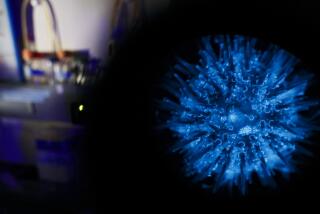Flying snakes and the science of jellyfish
The physicists, biologists and engineers were huddled around every available bar-height table in the Long Beach Convention Center, covering their tiny surfaces with laptops and notebooks. Posters in long, military rows showcased their efforts: An analysis of the movement of milk in English tea, a report on the stripes of gas across Jupiter.
In a hotel next door, Aryesh Mukherjee, a physics graduate student at Harvard University, was explaining how he built, with the help of rubber glove-like material, a synthetic voice box that could imitate a range of birdsongs.
Like Mukherjee, many of the scientists were gathered earlier this week at a fluid-dynamics conference to show how insights from the world of animals and plants might guide tomorrowâs technology â a burgeoning field known as bio-inspired engineering.
Some scientists reported on the aerodynamic antics of Chrysopelea paradisi, the paradise flying snake of Asia, suggesting it might â who knows? â aid in the creation of more sinuous search-and-rescue robots. Others are analyzing the movement of jellyfish, which they say could eventually lead to better designs for medical pumps and wind turbines.
Aerospace engineer Amy Lang of the University of Alabama showed how the scales of a speedy mako shark allow it to zip through the water so fast.
And USC engineer Geoffrey Spedding gave a talk proposing that airplanes be designed more like birds.
These scientists from far-flung fields share a common conviction: that future engineering has a great deal to learn from the natural world.
âThe number of people who are developing, encouraging, thinking about biologically inspired designs is vastly more than it was five years ago, two years ago even,â Spedding said. Even 15 years ago, ânobody took you seriously.â
But now, said researcher David Lentink of Wageningen University in the Netherlands, âbiologists and engineers are starting to talk with each other, and engineers are getting interested in what questions biologists would like to answer.â
Scientists are approaching that point of convergence from different directions. Speddingâs colleague Joachim Huyssen at the North-West University in South Africa designed an airplane on aerodynamic first principles â what kind of plane would, in theory, fly best. Spedding and Huyssen then tested the model in a wind tunnel. The best shape, the pair found, would have a bullet-like body rather than the elongated tube seen in commercial planes. The wings would be bent, the tail stubby.
The end result looked remarkably like a bird.
The research also has some inadvertent implications for understanding birds, Spedding added. Most planes have tails for stability, and biologists thought birds used theirs for the same reason. But because the research modelâs stubby, bird-like tail exists only to reduce drag, it may mean biologists need to rethink what those tail feathers really do for birds.
In a similar vein, Mukherjeeâs rubber bird voicebox suggested that birds might be using an as-yet-undiscovered muscle to produce sound. âIt might not be true,â Mukherjee said. âWeâre saying, âThis is what weâre doing ....and now, biologists, go see if this makes sense or not.â â
Some scientists in the field of bio-inspired engineering look directly to nature to see what designs could be put to good engineering use. Mark Murray, engineer at the U.S. Naval Academy, found that the saw-tooth-like bumps (called tubercles) running up the edge of a humpback whaleâs fin make the creatures perform better in low-flow water. This, in turn, implies that lining the blades of underwater turbines with similar bumps could make them much better at capturing energy from ocean tides.
And B.J. Balakumar from Los Alamos National Laboratory and colleagues built a robotic hummingbird wing to understand how one of the worldâs best (and in relative terms heaviest) hovering creatures manages to stay aloft. Learning how it hovers in gusty winds could help scientists develop quieter craft that could maneuver reliably even in bad weather.
Sometimes the simplest mechanisms are the most difficult to reproduce, said Janna Nawroth, a graduate student in the lab of Caltech engineering professor John Dabiri, who won a 2010 MacArthur fellowship for his research on jellyfish. If engineers could fully understand the way the creatures propel themselves, they could eventually use it medically, say for putting pumps inside the body, perhaps creating a better artificial heart, Nawroth said. The technology also could be used to make blade-free, bird-safe ways to collect wind energy, she added.
For all the fieldâs promise, Spedding said that scientists need to avoid just trying to imitate nature regardless of whether they can learn from it.
âJust because it exists in nature doesnât mean itâs an optimum ⦠the designs that come through evolution are just good enough to survive, thatâs all,â he said.
Nature, he noted, has yet to come up with a decent wheel.







